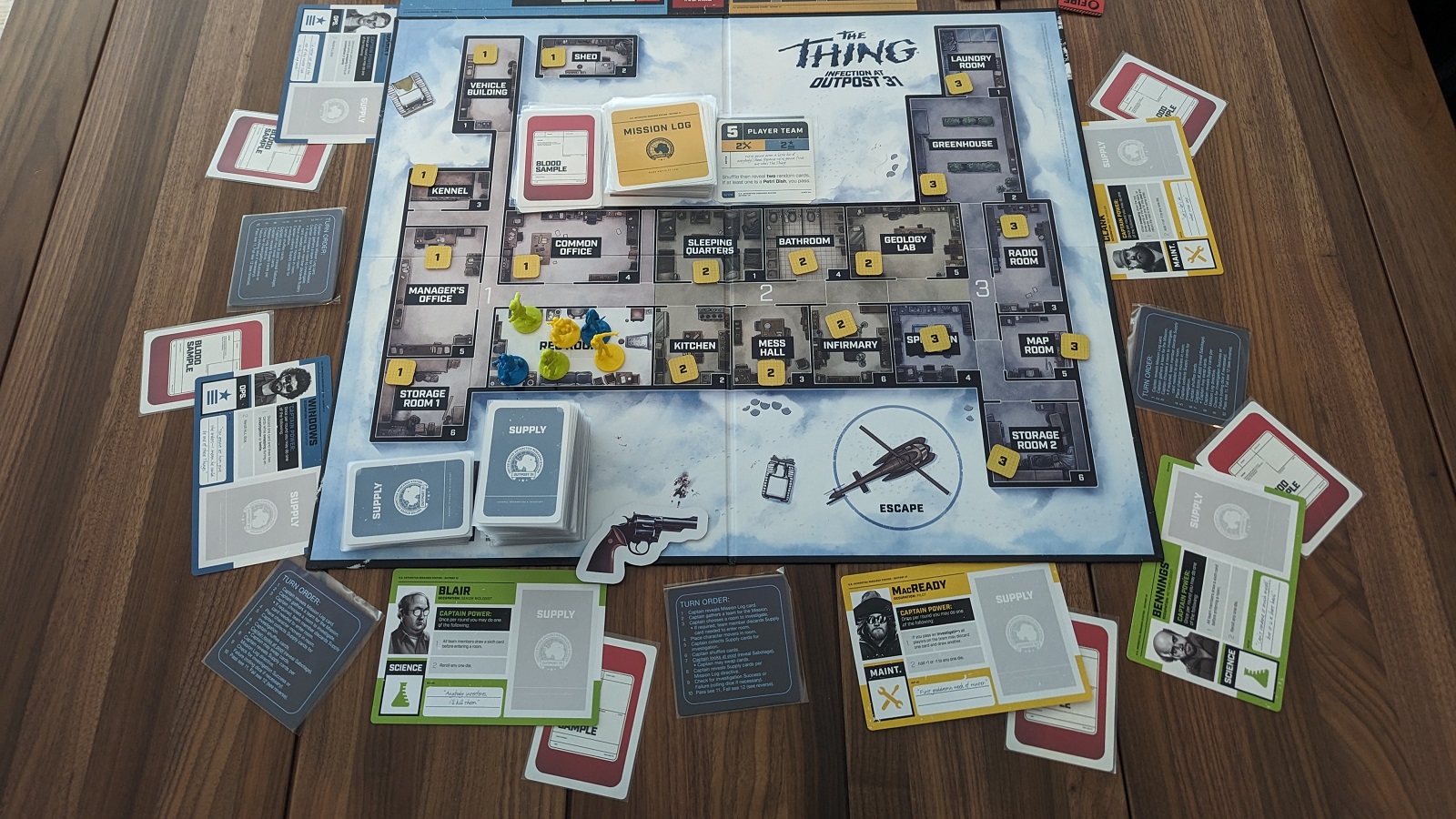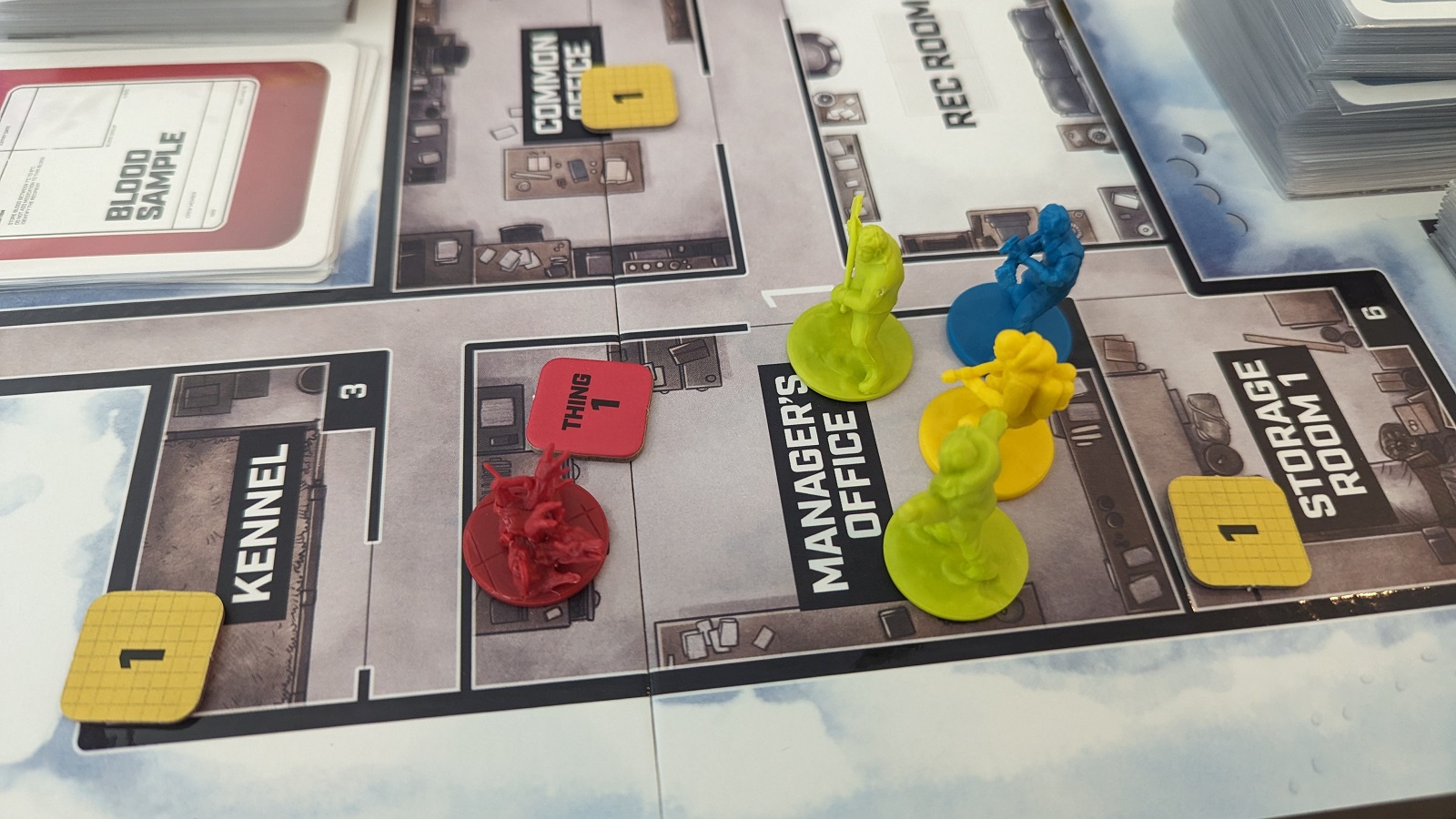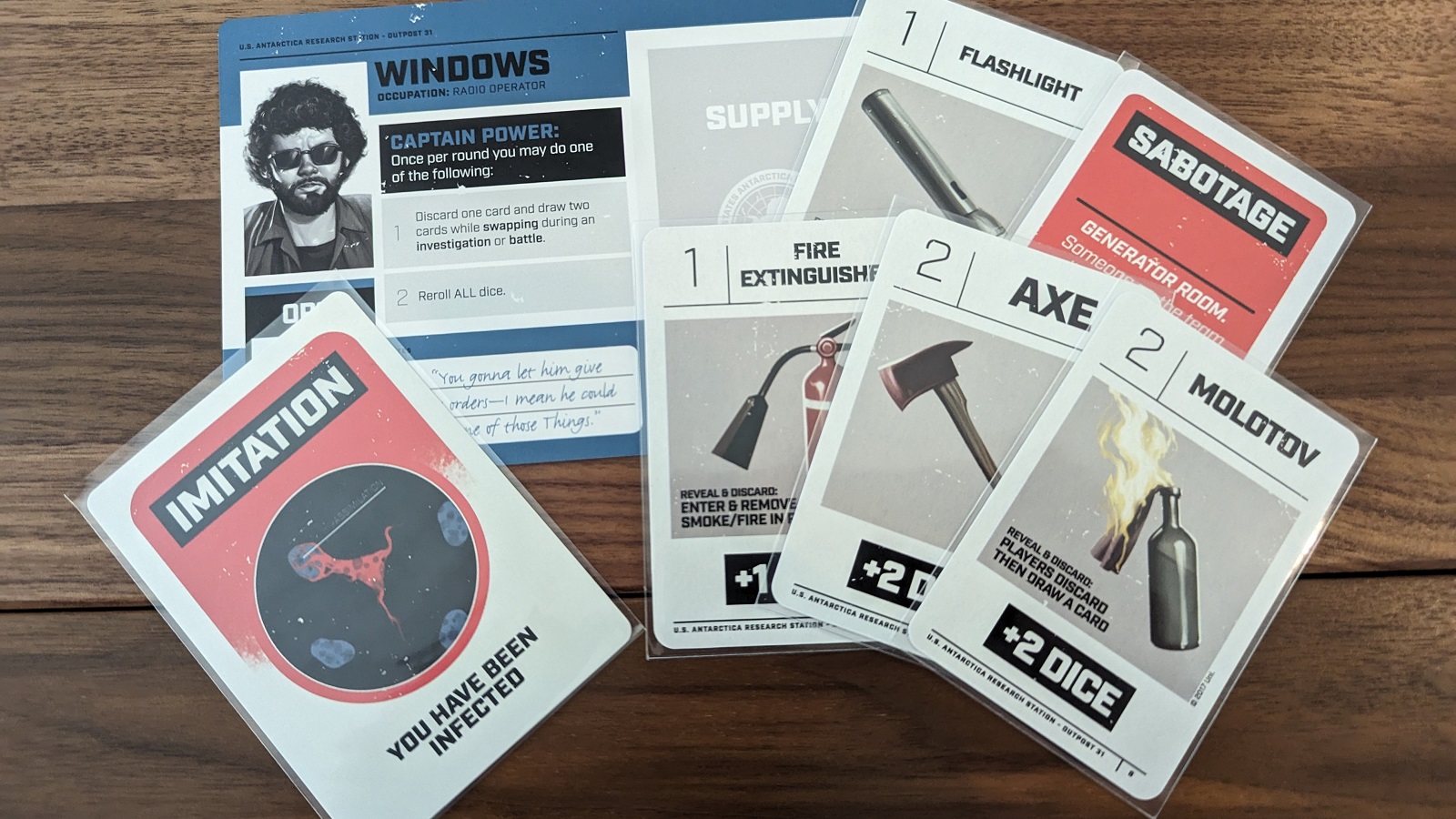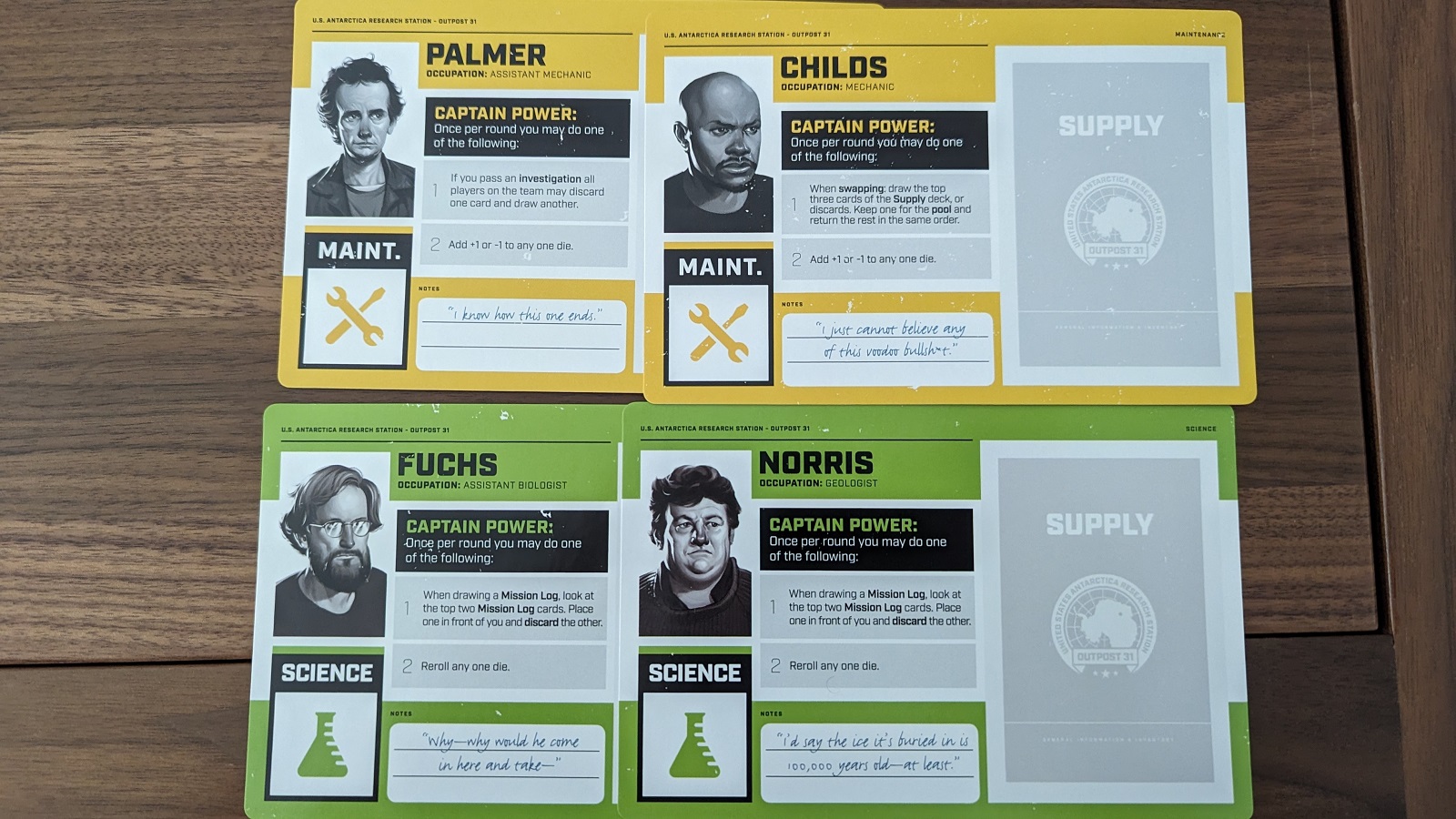Overview
Similar to a lot of hidden traitor style board games, Infection at Outpost 31’s design is largely based off of the skeleton of Battlestar Galactica (BSG.) BSG is a hallmark design from 2008 making it ancient by modern board game standards, but it revolutionized the hidden traitor genre so much that games still use its design as a template. Infection at Outpost 31 is one of the games closest in design to BSG, seeking to take that template and streamline it. In a lot of ways Infection at Outpost 31 succeeds.
In Infection at Outpost 31 there are two teams, the humans and the imitations. The humans are trying to survive long enough to figure out who is human and escape. The humans sole win condition is to reach the end of the game and escape with only humans on the helicopter. The imitations are trying to either destroy the base or blend in well enough to fool the humans and be among those on the helicopter at the end. This is the heart of a lot of hidden traitor games: if you’re among the normal majority, your task is to determine who is on your team through the course of the game. If you’re among the hidden minority, you’re trying to gain enough trust so that you can meet your team’s win condition.

The Thing: Infection at Outpost 31 main board
Going around the table, each turn there is a new captain that will choose a team for a mission card. The missions vary in character composition and supply card requirements so each captain has to try to pick the best team for their mission. The captain then picks a room to explore and each room contains a face down token that may contain what the humans need to advance their win condition. The base has three sectors, each of which has a specific requirement to advance. Sector One requires one rope to be found and one imitation NPC to be defeated. Once that has been accomplished, players move on to sector two. Once all three sectors of the base have been fully explored the game reaches its climax with the helicopter phase. Here a player will choose who gets the last ride out of Outpost 31 and whether or not the humans or imitations win. The end of the game can be a dramatic reveal as a single person tries to pick out the humans. There are players who want to make this choice, and others who do not want the pressure of winning/losing a game on their shoulders. After all, the game comes down to a single player’s choices.

A team of four fight the first Thing
Through the game, players will have hands of five cards from the supply deck and if a player is on a mission, they will submit one card face down to the captain. The supply deck contains a variety of items that have varying degrees of usefulness. Weapons excel at fighting NPC Things, flash lights illuminate dark rooms, and fire extinguishers put out fires. Since you never know what the mission will require, the game pushes you to have a variety of cards rather than trying to hold on to one type. Perhaps a mission needs a gun and an ax. Players human and imitation may or may not have those cards in hand when that mission comes up. If players do have them, they may be in the hands of helpful humans or the maybe helpful imitations. This is where the game shines. The discussions of who has what, or who can help are the heart of the trust building, decision making, and backstabbing. This is also one of the game’s pitfalls. It is possible for a mission to come up and no one actually has the cards needed for it. This only favors the imitation team, but it is an important space for them to lie. The imitations may have the cards needed for a mission, but can omit them from other players. In addition to the items, the supply deck contains sabotage cards. These cards can either put a heavy tax on a mission so that it may fail or they can outright fail a mission. If a mission fails the infection tracker moves up. If the infection tracker ever reaches the end the imitations win the game.The sabotage cards are really only for imitation players, and I will discuss their use a bit later.
There are other mechanics within the game; fire can break out, equipment can be gathered and NPC imitations fought with dice rolls. I’m not going to go over everything in detail, but even if it sounds like a lot, once you’ve played a round or two of Infection at Outpost 31 you’ll understand most of the game. The game plays well from round to round keeping discussions and accusations going. One last mechanic I will cover is borrowed straight from BSG to good effect. The first two times humans complete a section of the base there is a new “assimilation phase.” This means new identity cards are passed out to each player and if you ever draw an imitation card, you must keep it. You have become an imitation and have switched teams. This seeds more distrust as the game progresses. Can you still trust the same people as the game goes on, or have they switched teams? This mechanic also has the pitfall of luck. While unlikely, it is possible for an imitation player to draw a second imitation card. This means they are down a teammate in a game where they are already outnumbered. Despite the statistical improbability of this, I have seen this happen several times and it’s always no fun to know you’re missing a teammate.

Imitation Windows considers sabotaging a mission
Overall if you’re familiar with BSG (or other social deduction games) a lot of the elements in Infection at Outpost 31 will seem familiar. The game does a good job of streamlining the social deduction elements into a full experience. At 7-8 players Infection at Outpost 31 can be a blast with multiple discussions going on at once. Each player reevaluating each other as the game goes on. The heart of any social deduction game are the players themselves and Infection at Outpost 31 is a good outlet to lying to your friends.
Negatives
Infection at Outpost 31 does have its flaws. I’ve already mentioned luck as a factor throughout the game. Sometimes the game will go one way or another with little input from the players. This doesn’t happen often, but it can. The characters have asymmetrical powers, but they are very mechanical and don’t really have any theme to them. In addition, the difference in player powers is fairly minor. I never felt like I was a character from the movie. Like a lot of social deduction games Infection at Outpost 31 doesn’t play well at lower player counts. I would personally recommend at least six players. One of the few sticking points in the rules was the exact way you resolve missions, there are specific steps that involve checking for sabotage cards and the ability to swap cards at random. Players would get confused on the exact order of resolution. The game’s turn order card tried to help, but it was something we had to remind people of the most.

Player power examples
This last flaw is the big one that keeps the game from being a truly great social deduction game. Remember those sabotage cards I mentioned? Imitation players are likely going to want to play those into missions so they advance one of their win conditions. When sabotage cards pop up they are hard evidence that an imitation player was on the team. This prompts the discussions on who is good or evil. However, Infection at Outpost 31 lacks a backup strategy for players that are thought to be imitations or are imitations. What do I mean by this? If the other players think you’re an imitation, they can basically lock you out of the game. You may respond with, “Well, isn’t that the point of a social deduction game?” You’re not wrong, but other games in the genre have something for “revealed” bad guys to do if they get caught. Maybe it’s an entire other board or new actions, but it’s something to keep them in the game. At the very least other games provide new opportunities for a player to “prove” they are on the good team and win back that trust. Here, there isn’t much to prevent players from simply being excluded from play. Locking someone out of play is a viable strategy and may even be required if they are an imitation, but it’s not fun. It’s not fun to sit around waiting for a game to end because you’ve been “boxed out.” It feels even worse if you’re a human and someone else has laid enough blame on you since there’s nothing mechanically you can do about it. That is the nature of this social deduction game and someone has to be the “bad guy.” If you are found to be the “bad guy,” you can be locked out of the rest of the game. “Then don’t be the bad guy then,” someone replies. That may or may not be up to you, as you may never have useful cards. It’s possible as a human player to draw a bunch of sabotage cards meaning you can’t go on many missions without being an active detriment to your own team. There were discussions about the validity of holding on to sabotage cards as a human just to deny them to the imitation players and that seemed to be a highly controversial tactic. This flaw is the biggest stumbling block for Infection at Outpost 31 as it could be you left out of the game either justly or unjustly.
Components and 2nd Edition Updates
The components for Infection at Outpost 31 are fine. They’re nothing amazing and they also aren’t terrible. Character miniatures are color coded by their type which helps pick out who you need for your mission and the overall graphic design is good. I’ve always been amused that the captain token is a big cardboard revolver cause well, you listen to someone holding a gun. Why we pass it around though, who knows?
The game saw a small rules refresh with a 2nd edition, those changes are minimal. The biggest change is that the infection tracker board begins with one more endgame blood test. The blood tests allow the helicopter captain to fully flip a player’s allegiance card before choosing people to go on the helicopter at the end. The game now begins with three blood tests rather than two and humans can still lose access to these as the infection tracker moves higher. This change was intended to make the imitation players more active as playing as a “normal” human was too strong. Humans would get to the end of the game and just find out someone was an imitation and lose. While I applaud the attempt, it just highlights the glaring flaw I talked about earlier and creates more games where people do nothing.
Infection tracker (Note: first edition components shown.)
The updated rule book introduces several modes of play that may limit how detailed players can describe the cards in their hands. We played mostly on “Seasoned Mode.” Our play groups found that allowing players to fully talk about the cards being submitted made the game too difficult for imitations. Once all information was “known” it simply became a numbers game to find the outliers. Perhaps we would find counter strategies in time, but for us, it was too easy to narrow down the suspects. Each group will have to evaluate the communication limitation for themselves and the multiple options are a nice addition.
Final Thoughts
The Thing: Infection at Outpost 31 is a pretty good game. The game plays quickly and highlights the fun of social deduction. The goal of the design seemed to be to make a faster Battlestar Galactica and in that the game succeeds. The theme is mostly felt as you play, but isn’t quite all the way there. The lack of alternate actions for players who are “evil” is the games biggest flaw and no one likes being locked out of a game. If you’re looking for a moderate complexity social deduction game I can recommend Infection at Outpost 31, but it wouldn’t be my first pick.
Chris began tabletop gaming in college and quickly fell into the addictive world of cardboard. Beginning with D&D and Catan he became an enthusiast of all things gaming; analog or digital. Chris, now a relapsed MtG player, loves connecting with people via gaming through RPGs, board games, and video games. A particular favorite is testing friendships through social deduction games.

The Thing: Infection at Outpost 31 is a pretty good game. The game plays quickly and highlights the fun of social deduction. The goal of the design seemed to be to make a faster Battlestar Galactica and in that the game succeeds. The theme is mostly felt as you play, but isn’t quite all the way there. The lack of alternate actions for players who are “evil” is the games biggest flaw and no one likes being locked out of a game. If you’re looking for a moderate complexity social deduction game I can recommend Infection at Outpost 31, but it wouldn’t be my first pick.
PROS
- The social deduction elements work well
- Game doesn’t drag on too long
CONS
- Players can be “boxed out” of a game with nothing to do
- Luck can sometimes be frustrating for both teams
- Game does not play well at lower player counts
See below for our list of partners and affiliates:























